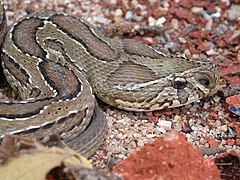Big Four (snakes)
Big Four is a term used on the Indian subcontinent for four venomous snake species. It has long been believed that they are responsible for almost all fatal snake bites in the region. Recent research refutes this.
In addition, Big Four is also a name for four types of giant snakes .
Poisonous snakes
Spectacled snake
Well wellIndian krait,
Bungarus caeruleusChain viper
Daboia russeliiCommon sand
otter Echis carinatus
The term was coined in the late 19th century and is based on the then knowledge of the taxonomy of snakes. Today, at least four species of cobra, eight species of krait and two subspecies of the common sand-rattle otter are known in the region, which can differ considerably in the composition of their poisons. In fact, bites from other species of snakes cause significant numbers of disease and death. Because of this, the term Big Four is only used occasionally in science today.
In India, only polyvalent snake sera are produced for poisoning by those four species. Recent research calls this approach into question, since even the poisons of different subspecies or populations of a snake species can have different compositions. In individual cases, the snake sera must be administered in greatly increased doses. The treating physicians describe them as not very effective. Often it was even found that a polyvalent snake serum produced in the south of India has a significantly lower effectiveness in the north of the country.
Giant snakes
Bellosa et al. use the term for four types of giant snakes , but the dark tiger pythons that occur on Sulawesi are extremely small with a length of up to 2.40 meters.
Large anaconda
Eunectes murinusDark Tiger
Python, Python molurus bivittatusReticulated python
Broghammerus reticulatusNorthern rock python
Python sebae
Web links
- The most dangerous venomous snakes: Asia tierchenwelt.de
- The Big 4 wildlifesos.org
Individual evidence
- ^ VV Pillay: Modern Medical Toxicology. 3rd edition , Jaypee Brothers Medical Publishers, New Delhi 2005, p. 124, ISBN 978-8180615191 , online preview , accessed January 26, 2014.
-
^ Oscar H. Del Bhutto: Neurologeous effects of venomous bites and stings: snakes, spiders, and scorpions . Pages 350/351
In: Hector H. Garcia, Herbert B. Tanowitz, Oscar H. Del Brutto (Eds.): Neuroparasitology and Tropical Neurology: Handbook of Clinical Neurology . Elsevier BV Amsterdam 2013 - ↑ Henry Bellosa, Lutz Dirksen, Mark Auliya: The fascination of giant snakes: Myth, facts and stories. Blv Buchverlag, 2007, ISBN 978-3835402829 .
- ^ A b Romulus Whitaker, Samir Whitaker: Venom, antivenom production and the medically important snakes of India . In: Current Science , Volume 103, Number 6, pp. 635–643, ISSN 0011-3891 , Online PDF 119 kB, accessed on January 26, 2014.
- ^ Oscar H. Del Bhutto: Neurologeous effects of venomous bites and stings: snakes, spiders, and scorpions . In: Hector H. Garcia, Herbert B. Tanowitz, Oscar H. Del Brutto (Eds.): Neuroparasitology and Tropical Neurology: Handbook of Clinical Neurology . Elsevier BV, Amsterdam 2013, pp. 349–368, here pp. 350–351, ISBN 978-0444534903 Online preview , accessed on January 26, 2014.
- ↑ M. Szell: blog post "Poisonous Snakes in India" [1] , accessed on February 8, 2015.
- ↑ Diganta Das et al .: Biochemical and biological characterization of Naja kaouthia venom from North-East India and its neutralization by polyvalent antivenom . In: Journal of Venom Research , Volume 4, 2013, pp. 31–38, ISSN 2044-0324 , PMC 3861878 (free full text)
- ↑ HJ Jacobs, M. Auliya, W. Böhme: To the taxonomy of the dark tiger python, Python molurus bivittatus KUHL, 1820, especially the population of Sulawesi. In: Sauria , 2009 ( online )







